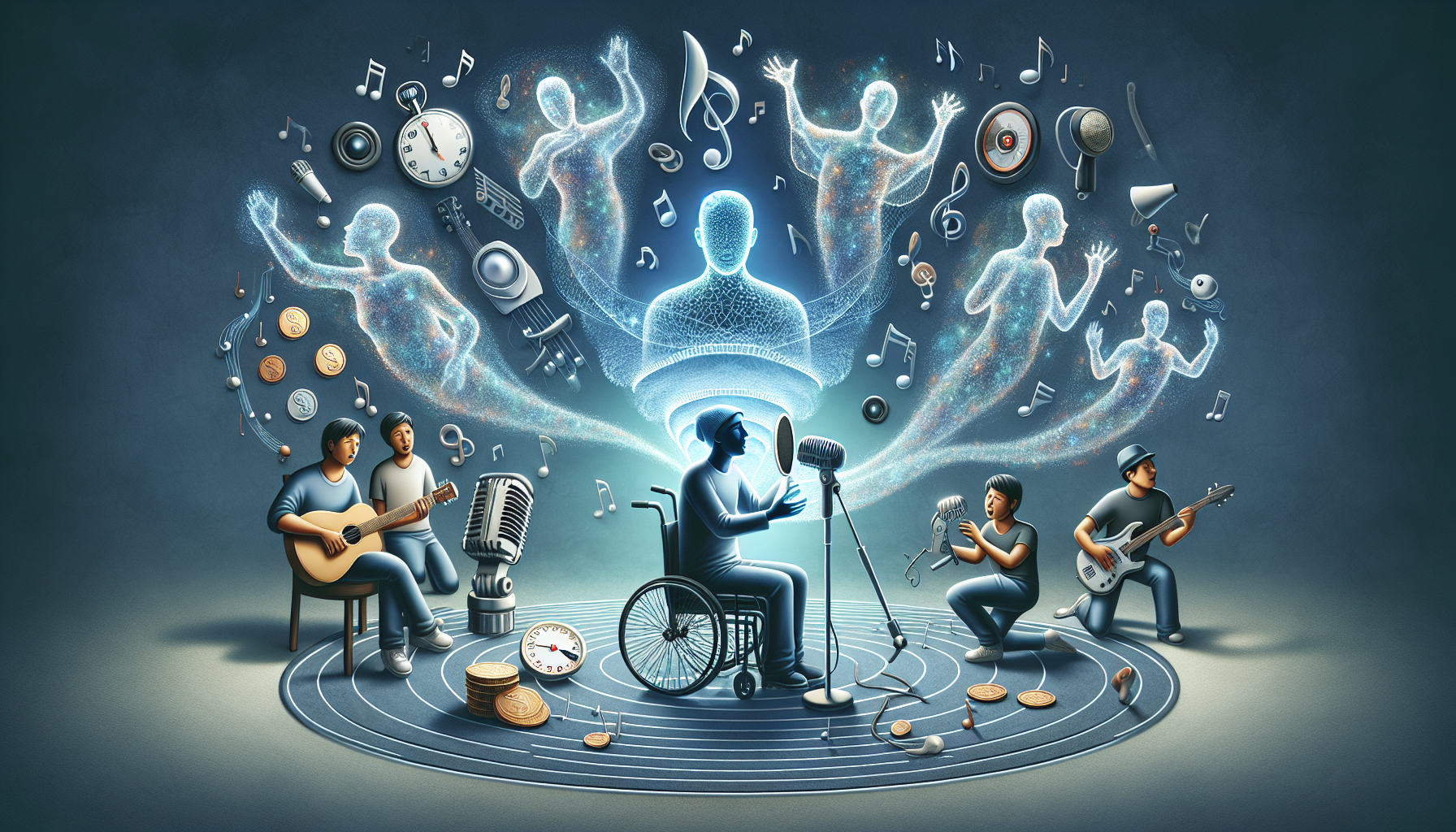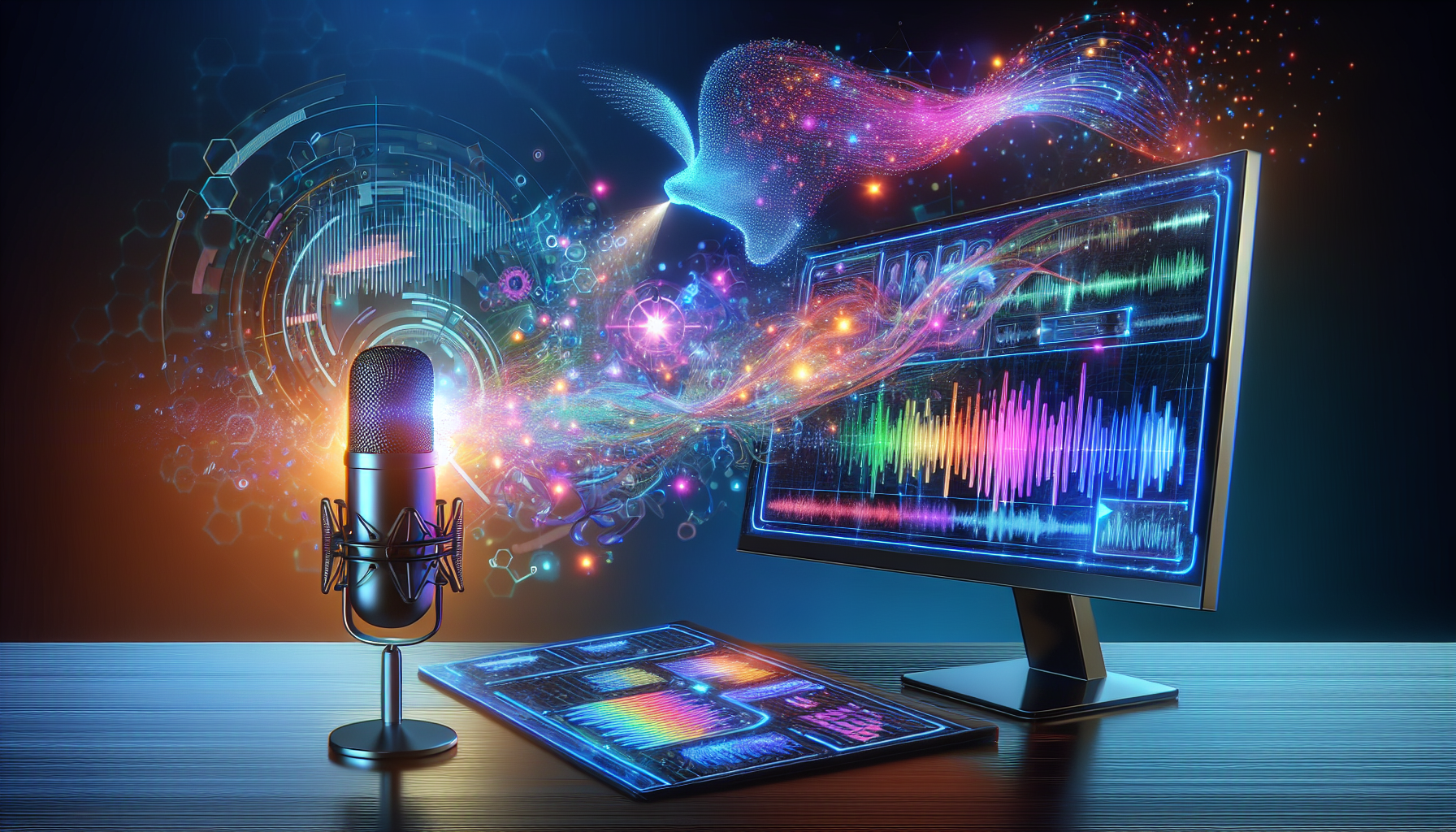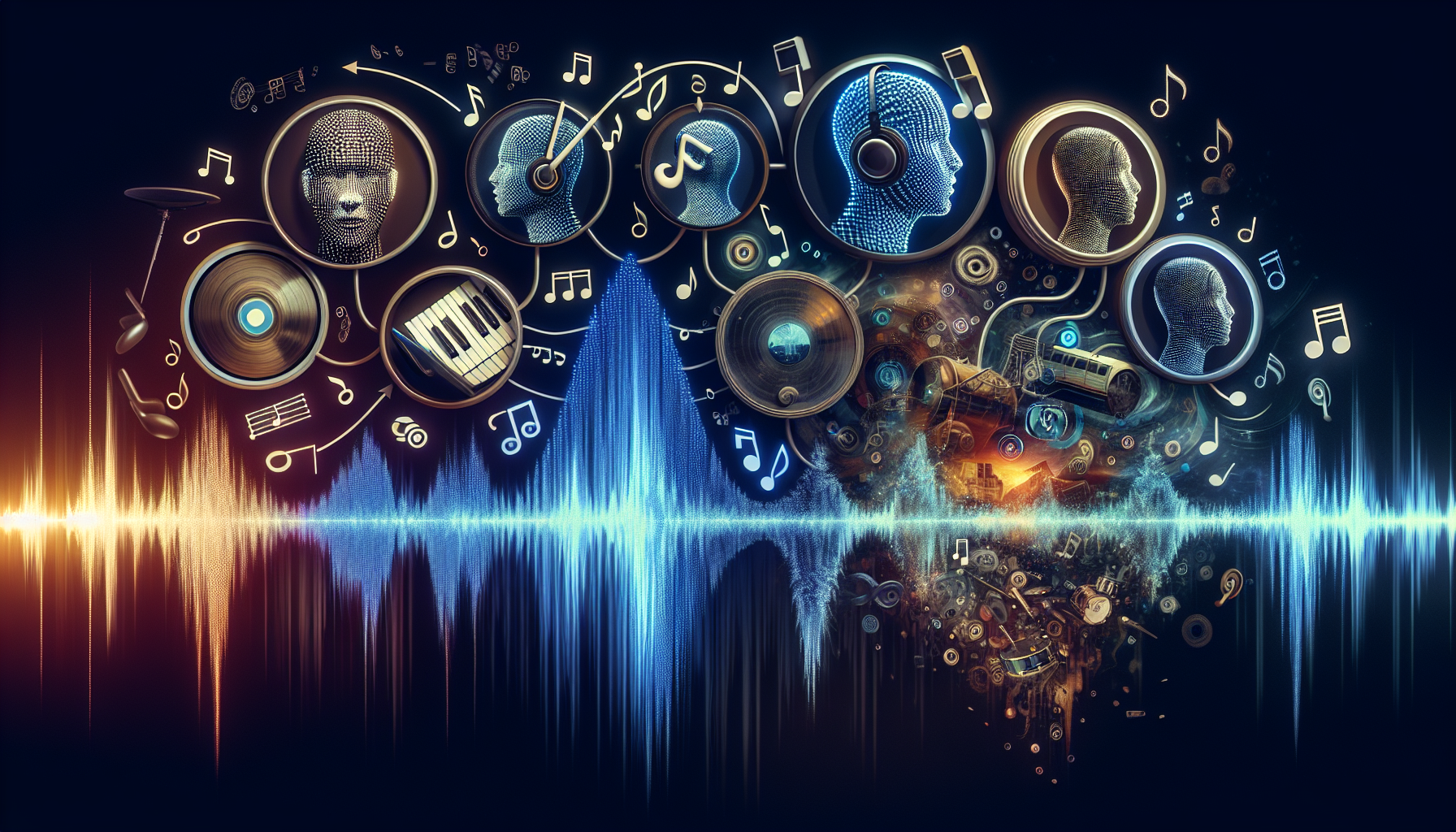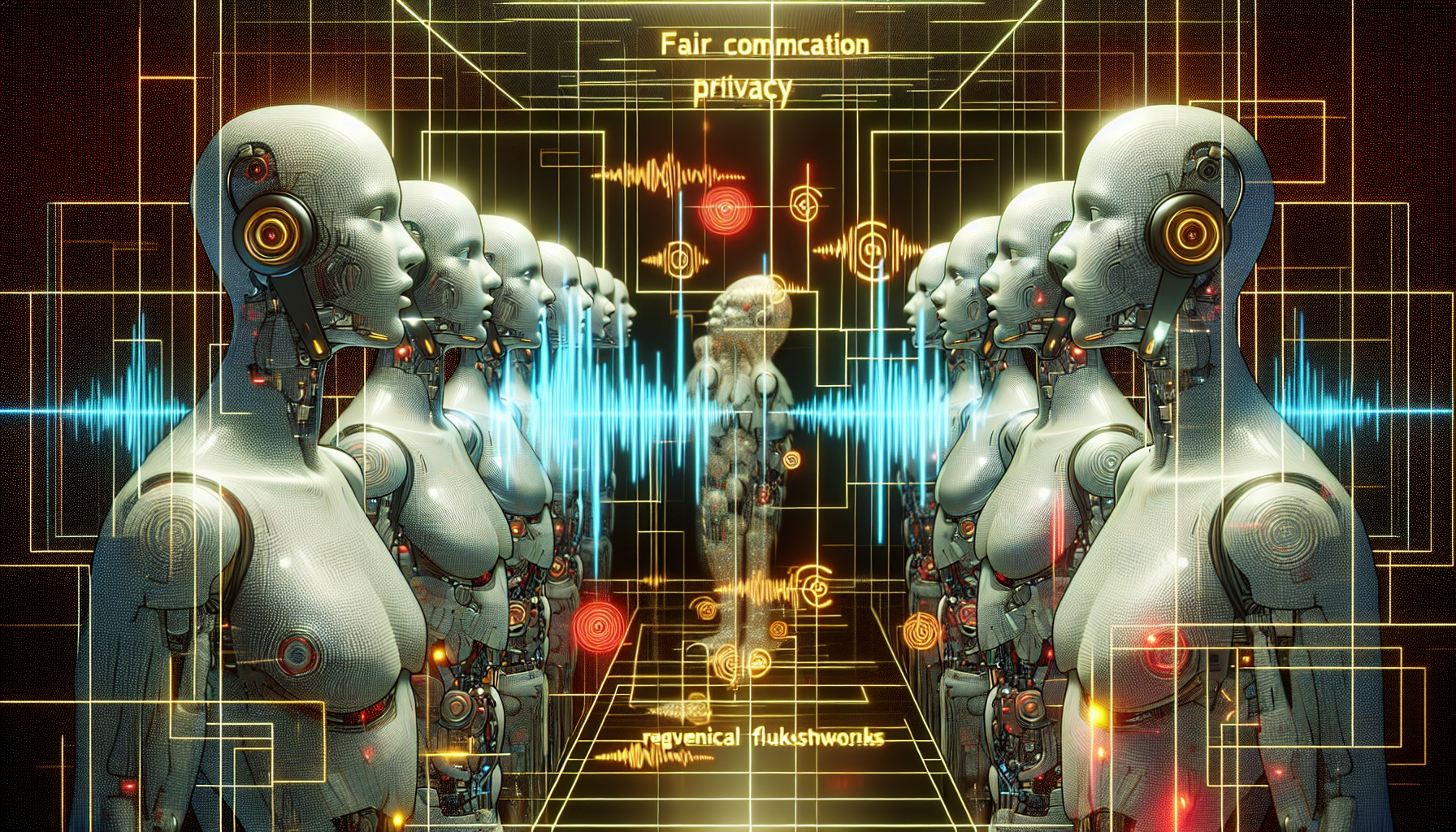Paul
Jun 21, 2024
Table of Contents |
The future of AI voice cloning in music holds profound implications for artists, producers, and the entire industry. This technology is set to change how music is created, redefining the boundaries of artistic expression and the roles of vocalists. But it also raises questions about authenticity, ethics, and the essence of human creativity. In this article, we explore how AI voice cloning could reshape the musical landscape, its potential applications, and the challenges it brings.
Key Takeaways
- AI voice cloning tech has advanced rapidly, enabling realistic replication of voices with minimal audio samples, revolutionizing how voices are synthesized and used in various applications.
- In music production, AI voice cloning offers significant benefits, such as cost-effectiveness, creative flexibility, and the ability to produce high-quality vocal tracks quickly, even allowing for AI-generated vocals.
- While AI voice cloning opens up new creative and commercial possibilities, it also raises ethical concerns regarding voice ownership, consent, and the potential for misuse, underscoring the need for regulatory frameworks and responsible usage practices.
Evolution of Voice Cloning Technology in Music

Voice cloning technology began its journey in the late 1990s with initial methods focusing on text-to-speech (TTS) systems, designed to convert written text into spoken words. These early systems used techniques like concatenative synthesis, which involved piecing together pre-recorded segments of speech. While innovative for its time, the technology had limitations in producing natural-sounding speech due to the fragmented nature of the synthesis.
A significant breakthrough came in 2016 with the development of WaveNet by DeepMind.
What is DeepMind and Wavenet?
|
Following WaveNet, Baidu, a Chinese multinational technology company, introduced the Deep Voice series in 2017. These were models that further advanced voice synthesis by leveraging neural networks, moving away from traditional text-to-speech methods. Deep Voice improved the clarity of synthesized voices and significantly reduced background noise, enhancing the overall quality of generated speech.
Voice cloning technology has evolved to create highly accurate clones that preserve the unique vocal traits of the original speaker. This opens up many applications. Modern voice cloning enables personalized experiences, such as custom voice assistants that mimic a specific person. It also supports assistive technologies, allowing those who have lost their ability to speak to communicate in a voice similar to their own. In entertainment, voice cloning enhances dubbing movies and crafting realistic voiceovers for video games. For example, FN Meka, an AI-generated rapper created by Factory New, demonstrates the integration of voice cloning in music production.
1990s: Text-To-Speech Concatenative synthesisWhile this approach was innovative at the time, it struggled to produce natural-sounding speech because the combined segments often didn't flow smoothly, resulting in robotic and fragmented audio. |
2016: Speech Synthesis Wavenet by DeepmindCould generate speech that captured the subtle nuances of human voice, including intonation, rhythm, and even breathing patterns. |
2017: Advanced Speech Synthesis Deepvoice Series by BaiduImproved the clarity of synthesized voices and significantly reduced background noise, enhancing the overall quality of generated speech. |
How AI Voice Cloning Works

The mechanism of AI voice cloning can be compared to a maestro conducting an orchestra, where every instrument must harmonize perfectly. The technology analyzes a person’s voice across various situations to understand the intricacies of speech patterns, intonations, and nuances. Through a voice cloning tool, a digital model is built that can accurately replicate the target voice, even creating new words or expressions that the original voice never uttered.
Capturing Emotion with Voice Cloning
Cloning voices is a craft that ventures beyond mere sound copying; it involves capturing the essence of a person’s speech, inclusive of tone and emotional nuances. Creating the perfect voice clone is a meticulous process, requiring multiple rounds of sampling and refinement to achieve a result that’s nearly indistinguishable from the original. This technical ballet involves state-of-the-art AI voice cloning technology such as WaveNet, Tacotron-2*, and Deep Voice 3, each contributing their unique strengths to the ensemble. With these advancements, it’s now possible to clone your voice with remarkable accuracy, producing a convincing cloned voice.
Moreover, the advent of transfer learning, as seen in systems like SV2TTS*, has simplified the process, allowing for the generation of speech with minimal reference audio. This means that AI can produce natural sounding speech from a small set of voice recordings, effectively learning to speak in one’s voice from just a few examples.
What is SV2TTS?SV2TTS is a high-tech system for creating realistic synthetic voices. The name SV2TTS stands for "Speaker Verification to Text-to-Speech" and the system typically involves three main stages: |
1. Speaker Encoder It takes a short recording of someone speaking and analyzes it to create a unique digital profile of that person's voice. |
2. Synthesizer It uses the voice profile and text to produce a spectrogram, which is like a picture of sound frequencies, keeping the voice sounding like the original person. |
3. Vocoder It converts the spectrogram into actual audio, producing the final synthetic voice that sounds like the target person. |
Tacotron 2: Advanced Text-to-Speech SystemTacotron 2 is a system created by Google that turns written text into spoken words that sound very natural, almost like a human. Tacotron 2 significantly improves the quality of synthesized speech compared to previous TTS systems. It can produce speech that is nearly indistinguishable from human speech in terms of naturalness and intelligibility. |
Key Features and Components:
Tacotron 2 generates speech directly from raw text using a single neural network, simplifying the speech synthesis process and improving the naturalness of the generated speech.
This part of the model converts input text into a spectrogram, a visual representation of the sound frequencies over time. It uses a sequence-to-sequence model with attention mechanisms to map sequences of characters (input text) to sequences of spectrogram frames, capturing the nuances of pronunciation, intonation, and rhythm from the text.
The spectrogram produced by the text-to-spectrogram network is fed into WaveNet, a generative model that converts the spectrogram into a high-quality audio waveform. Developed by DeepMind, WaveNet generates highly realistic and natural-sounding speech by producing audio waveforms from the spectrogram frames. |
Collaboration and Sharing in the AI Era
Collaboration is a key part of the music creation process, and AI makes it easier than ever. Real-time collaboration features on AI music platforms enable artists and producers worldwide to jointly work on music projects effectively.
Whether you’re creating a hit single with a producer halfway across the world or working on a soundtrack for a video game with a team of composers, AI music tools have got you covered.
Applications and Impact
Tacotron 2 has a wide range of applications, including:
- Voice Assistants: Enhancing the naturalness of voices in virtual assistants like Google Assistant.
- Audiobooks: Generating lifelike narrations for audiobooks.
- Accessibility: Providing better text-to-speech options for visually impaired individuals.
- Entertainment: Creating more realistic voices for characters in video games and animated films.
Applications of AI Voice Cloning in Music Production

In the studio, AI voice cloning technology provides a range of tools that are impacting music production. Digital replicas of human voices can now not only speak but sing and emote, adding an unprecedented layer of creativity to musical projects. Artists are now experimenting with different voice models and settings to find that perfect vocal fit, blending AI-generated vocals with live recordings to strike a chord that resonates on a deeply emotional level.
The efficiency of voice cloning is music to the ears of producers and musicians. In a world where time is of the essence, having the ability to produce vocal tracks quickly without a compromise on quality is invaluable. Moreover, the cost-effectiveness of AI voice cloning mitigates the need for session vocalists, providing a budget-friendly alternative that still delivers high-quality background vocals or harmonies. Read more about the cost-effectiveness…
Advancements in AI voice cloning now make it possible to create songs with high-quality celebrity voices. You can imagine tracks featuring The Weeknd, Drake, or even legendary artists like Michael Jackson. Technologies like those from Lalals.com employ sophisticated neural networks to replicate the unique vocal traits of these celebrities. This allows the production of new audio that mimics their style with remarkable accuracy.
Case Studies: Successful Uses of AI Voice Cloning in Music
Real-world applications provide a glimpse into the true potential of AI voice cloning in music. Some examples include:
- Holly Herndon’s ‘Holly Plus,’ which allows artists to utilize an AI-generated voice clone in their compositions
- The voice of the late Anthony Bourdain being brought back to life in documentaries, ‘speaking’ lines he once wrote, thanks to the power of AI
- Actor Val Kilmer, whose voice was damaged by throat cancer, finding his voice once again with the help of a startup called Sonantic that crafted his AI voice clone.
These examples demonstrate the versatility and impact of AI voice cloning in various industries.
These case studies not only showcase the technological prowess of AI voice cloning but also its ability to touch hearts and evoke emotions. By understanding the power of deep learning and generative voice technologies, artists and filmmakers can create a synthetic voice that carries the essence of the original, making the impossible, possible.
The potential uses for AI voice cloning in music are not limited to replacing lost voices. They also serve as a tool for innovation and creativity, enabling musicians to collaborate with virtual versions of themselves or other artists, paving the way for new forms of expression and artistry.
Benefits of AI Voice Cloning for Musicians
For musicians, the advantages of AI voice cloning resemble discovering a new instrument capable of playing any note in any style. The reduction in time and cost associated with traditional recording processes is a game-changer, freeing artists from the constraints of scheduling studio time and hiring session musicians. The ability to quickly prototype and experiment with different vocal sounds during the early stages of production allows for greater artistic flexibility and creativity.
The creation of custom voices is no longer a luxury reserved for the few; it has become accessible to all, giving musicians the ability to craft unique and personalized vocal sounds that resonate with their artistic vision. This democratization extends to artists with limited resources or those facing physical limitations, offering them a chance to express their own voice, or even create a person’s voice, in an industry where the ability to produce high-quality recordings can make or break a career.
Moreover, AI voices can seamlessly switch between languages, offering musicians the opportunity to reach a global audience without the barriers of language. With AI voice cloning, the quality of the vocal production remains consistent and reliable, ensuring that every note and every word is delivered with precision, regardless of the project’s scope. By creating their own AI voice, musicians can further personalize their sound and connect with listeners on a deeper level. Read more…
Future Possibilities and Innovations

Looking ahead, AI voice cloning promises endless possibilities and a harmonious future. Innovations in voice synthesis and multilingual support are emerging, simplifying the creation of realistic voices for a diverse audience. The applications extend beyond the music industry to virtual reality, gaming, and interactive storytelling. Here, personalized AI companions with individualized voices can create immersive experiences.
The voice cloning market is experiencing rapid growth, projected to reach $7.9 billion by 2030. This indicates significant financial investment and a commitment to enhancing the technology. Soon, just a few minutes of audio could allow the creation of unlimited voices with a personal touch. This reduces the learning curve for new users and expands the reach of AI voice cloning.
As AI technology matures, the music industry is entering a new era where the distinction between human and synthesized voices becomes increasingly blurred. Artists, producers, and creators now have the power to conjure any voice they can imagine. This capability ushers in a symphony of sounds previously impossible, all thanks to artificial intelligence.
Ethical Considerations and Challenges
Despite the opportunities presented by AI voice cloning, it also brings with it some discordant notes in the form of ethical considerations that demand attention. The importance of fair compensation and recognition for artists, especially when their voices are used posthumously, is a pressing concern. The music industry is grappling with the need for regulatory frameworks to protect against unauthorized replication of voices and ensure responsible usage.
The ethical terrain of AI voice cloning is complex. Privacy concerns and potential misuse often overshadow its benefits. Companies like Fliki lead the charge in responsible usage. They implement script approval processes and actively monitor and enforce ethical guidelines. However, there is also fear of music homogenization and loss of individuality with widespread AI adoption. These concerns continue to fuel the ongoing debate.
The use of AI, especially in recreating the voices of deceased singers, elicits strong emotional responses. These responses highlight the ethical dilemmas involved. As we advance, thinking critically about the creation and use of voice and video segments is crucial. We must ensure authenticity and consent lead this technological revolution. Read more…
Summary
AI voice cloning has become both a virtuoso and a provocateur in the music industry. It offers a spectrum of creative opportunities and challenges our concepts of authenticity and ownership. From its humble beginnings to its sophisticated current state, voice cloning technology has emerged as a powerful innovation tool. Yet, it carries significant ethical responsibilities. As we enter this new era, it is crucial to navigate the highs and lows mindfully, ensuring that our values harmonize with the ongoing music. How do I stay authentic as an artist while using AI?
Frequently Asked Questions
All you need to know about Lalals.
What is AI voice cloning?AI voice cloning is the creation of a computer-generated voice that closely mimics a real human voice, using speech patterns and intonations. It aims to produce a digital version that is virtually indistinguishable from reality. |
Can AI voice cloning be used for speaking as well as singing?Absolutely! AI voice cloning technology can be used for both speaking and singing, opening up a variety of possibilities in music production and other fields. Try it out for your next project! |
Are there ethical concerns with using AI voice clones?Yes, there are ethical concerns with using AI voice clones, such as fair compensation for artists, privacy maintenance, prevention of misuse, and ensuring consent and transparency when using cloned voices. Read more… |
What are some real-world applications of AI voice cloning in music?AI voice cloning has been used in music to create digital clones of artists’ voices for collaboration and to recreate the voices of deceased performers for documentaries and other productions. It allows for the replication of a specific individual’s voice, contributing to artistic and storytelling endeavors. |
How does AI voice cloning impact the future of content creation?AI voice cloning transforms content creation. It offers efficient workflows, cuts production costs, and allows for personalized content in areas such as virtual reality, gaming, and interactive storytelling. It has a significant impact on the future of content creation. |
Convert Your Voice with AI
Make your voice sound like those of famous arists.
Join Lalals and use our hyper-realistic voice converter now.